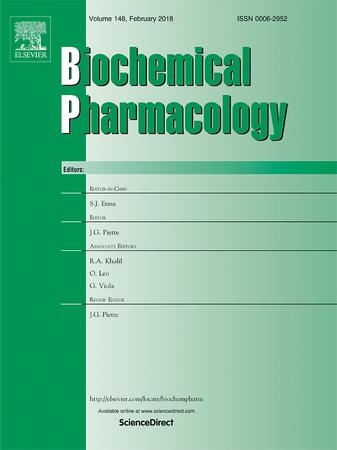Mechanisms of action of ubiquitin-specific proteases, particularly ubiquitin-specific proteases 7, 8, and 25, in depression treatment
IF 5.3
2区 医学
Q1 PHARMACOLOGY & PHARMACY
引用次数: 0
Abstract
Depression is one of the most common and debilitating mental disorders and one of the main causes of disability worldwide. Despite the progress made in the treatment of depression, approximately 20 %–40 % of patients with a major depressive episode do not show a clinical response to current antidepressant treatments. Approximately 85 % of patients with major depressive disorder (MDD) experience a high relapse rate after recovering from an acute episode of major depression. Over the past decade, protein ubiquitination and deubiquitination have attracted considerable interest. An increasing number of studies have shown that ubiquitin-specific proteases (USPs) play essential roles in the pathogenesis of depression. USP is part of the ubiquitin–proteasome system (UPS), a critical non-lysosomal pathway specific for protein degradation, and plays a significant role in presynaptic and postsynaptic proteins crucial for regulating neurotransmission and synaptic plasticity. However, its potential contribution to the pathophysiology of depression has not yet been addressed in detail. Therefore, this review explores the potential of targeting USP as a novel approach to antidepressant treatment, focusing on the targets and mechanisms of USP in the regulation of depression. By providing insights into USP in preclinical research, this review aims to contribute to developing new therapeutic methods for enhancing the efficacy of antidepressant treatments.

泛素特异性蛋白酶,特别是泛素特异性蛋白酶7、8和25在抑郁症治疗中的作用机制
抑郁症是最常见的精神障碍之一,也是全世界致残的主要原因之一。尽管在抑郁症治疗方面取得了进展,但大约20% - 40%的重度抑郁症患者对目前的抗抑郁药物治疗没有表现出临床反应。大约85%的重度抑郁症(MDD)患者在重度抑郁症急性发作后恢复后有很高的复发率。在过去的十年中,蛋白质泛素化和去泛素化引起了人们极大的兴趣。越来越多的研究表明泛素特异性蛋白酶(USPs)在抑郁症的发病机制中起着重要作用。USP是泛素-蛋白酶体系统(UPS)的一部分,是蛋白质降解的关键非溶酶体途径,在突触前和突触后蛋白中发挥重要作用,对调节神经传递和突触可塑性至关重要。然而,其对抑郁症病理生理的潜在贡献尚未得到详细阐述。因此,本文探讨了USP作为抗抑郁药物治疗新途径的潜力,重点探讨了USP在抑郁调节中的作用靶点和机制。通过对临床前研究USP的深入了解,本综述旨在为开发新的治疗方法以提高抗抑郁药物治疗的疗效做出贡献。
本文章由计算机程序翻译,如有差异,请以英文原文为准。
求助全文
约1分钟内获得全文
求助全文
来源期刊

Biochemical pharmacology
医学-药学
CiteScore
10.30
自引率
1.70%
发文量
420
审稿时长
17 days
期刊介绍:
Biochemical Pharmacology publishes original research findings, Commentaries and review articles related to the elucidation of cellular and tissue function(s) at the biochemical and molecular levels, the modification of cellular phenotype(s) by genetic, transcriptional/translational or drug/compound-induced modifications, as well as the pharmacodynamics and pharmacokinetics of xenobiotics and drugs, the latter including both small molecules and biologics.
The journal''s target audience includes scientists engaged in the identification and study of the mechanisms of action of xenobiotics, biologics and drugs and in the drug discovery and development process.
All areas of cellular biology and cellular, tissue/organ and whole animal pharmacology fall within the scope of the journal. Drug classes covered include anti-infectives, anti-inflammatory agents, chemotherapeutics, cardiovascular, endocrinological, immunological, metabolic, neurological and psychiatric drugs, as well as research on drug metabolism and kinetics. While medicinal chemistry is a topic of complimentary interest, manuscripts in this area must contain sufficient biological data to characterize pharmacologically the compounds reported. Submissions describing work focused predominately on chemical synthesis and molecular modeling will not be considered for review.
While particular emphasis is placed on reporting the results of molecular and biochemical studies, research involving the use of tissue and animal models of human pathophysiology and toxicology is of interest to the extent that it helps define drug mechanisms of action, safety and efficacy.
 求助内容:
求助内容: 应助结果提醒方式:
应助结果提醒方式:


